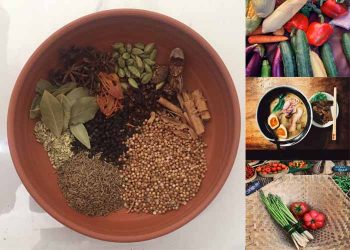Ayurveda a new hope for healthy eating


Pathirage Kamal Perera
Senior Lecturer, Consultant Physician, Institute of Indigenous Medicine University of Colombo, drkamalperera@yahoo.com
Ayurveda places special emphasis on Ahar (diet) and Anna (food) and believes that healthy nutrition nourishes the mind, body and soul. A person having sound mind, intellect, physical strength, energy and psychological strength, one who is desirous of attaining benefits in this world and the other world (after death). These desires are desire for long and healthy life, desire for wealth (livelihood), and desire for a blissful life in the other world (after death).
Ayurveda and customized diet
With effective integration of “omics,” Prakriti-based medicine can play a vital role in this changing scenario of global health wisdom as Ayurveda offers its modalities by way of Ahara (diet), Vihara (lifestyle) and Aushadhi (medication) which are the three pillars of Prakriti-based medicine making it a holistic science. Sri Lankan Ayurveda emphasize the food and nutrition in a highly individualized manner as it believes that every individual is unique having different constitution. Therefore, pattern of diet and food regimens should towards more personalized manner. This is independent of racial, ethnic, or geographical considerations and may provide appropriate nutritive health. Similarly, these traditional systems classified the drugs according to the Rasapanchaka (Ayurvedic pharmacology), which states that the food action is endorsed to certain attributes present in the food namely Rasa (taste), Guna (property), Virya (potency), Vipaka (Post digestive taste) and Prabhava (effect) while in modern pharmacology the food action is attributed to the chemical composition and calorific value. The Rasapanchaka modality can deliver nutritive treatment as it takes into consideration the Prakriti of the person as well as the digestive properties of a food unlike modern dietary plans that expected varied response from person to person having same physical dietary plans.
Current food pyramid design and Ayurveda way
My-Plate is the current nutrition guide published by the United States Department of Agriculture, depicting a place setting with a plate and glass divided into five food groups. It replaced the USDA’s MyPyramid guide, concluding 19 years of USDA food pyramid diagrams. MyPlate is divided into four sections of approximately 30 percent grains, 40 percent vegetables, 10 percent fruits and 20 percent protein, accompanied by a smaller circle representing dairy, such as a glass of milk or a yogurt cup. The western point of view food quantity is determined by serving size, portion size or in caloric intake.
But over the years and several research findings later, it was concluded that the recommended food pyramid had greatly faltered in providing a basis for a balanced diet since as non-communicable diseases was on the rise. Most of the modern dietary requirements are formulated on the basis of research data available on chronic diseases, cardiovascular and cancer risk factors at this time, using cholesterol ratios and triglyceride levels as indicators of wellness across the broader.
In contrast to western dietary understanding, Ayurveda states that a diet can be vegetarian (plant based) or non-vegetarian (animal based) and portion size should be customized for each individual according to one’s own requirements considering body constitution (Prakirti- Physical and mental status) and digestive power (Agnibala). Thus the quality and quantity of food is often weighed on the basis of how effectively the food is digested. Further Ayurveda emphasizes that a diet must be accurately selected and wisely formulated, not only according to the physical conditions of a person, but taking into consideration the body type (Vata, Pitta and Kapha) and should complement the seasonal and daily changes and other natural factors that surround an individual. According to Ayuveda the use of wholesome food (Pathya) promotes health, while unwholesome food (Apathya) manifests disease. Therefore, food is classified on the basis of its properties and its effects on the digestion.
According to the Ayurveda taste (Rasa) plays a major role in proper digestion, classification of food and food group are developed according to taste. The six tastes (Rasa) of the food constitute: sweet (Madhura), sour (Amla), salty (Lavana), bitter (Tikta), pungent (Katu) and astringent (Kasaya). These six tastes also correspond to the six stages of digestive process. Each taste plays an important role in the stimulation of the digestive and immune systems. Each taste stimulated by the food contributes to the nourishment of the body when consumed in appropriate quantity otherwise it leads to disease conditions (Table 1). According to the Ayurveda balance diet include the six Rasa according to the personal requirement. Not considering the personal situation different foods are taken in combination and their properties are not complimentary, indigestion, flatulence, and acidity can arise and toxins (Ama) are formed in the body and caused diseases.
According to the Ayurveda classical text of Charaka Samhitha the light food-articles are stimulants of digestive power (Agni) owing to their innate quality, and are said to be less harmful even if they are eaten to a surfeit. On the other hand, heavy articles are non-stimulant of digestive power (Agni) by nature, due to their dissimilarity of qualities with human cells. Thus, they cause harm if taken in excess quantity, unless there is strong digestive power (Agni) achieved by physical exercise. Thus the right quantity of diet is determined by the strength of digestive power (Agni). Ayurveda provides a guide on how to combine food for optimum nutrition and proper digestion. Therefore, Ayurveda is a great science of properly combining foods and food substances to maintain optimal health.
Table 1: Diseases caused by excessive use Rasa
| Rasa | Diseases caused by excessive use Rasa |
| Madhura | Obesity, depression, heaviness, loss of appetite, abnormal growths, cough, asthma, coryza, digestive disorders, vomiting, cold fever, hoarseness of voice, goiter, lymphadenitis, tumours, conjunctivitis, etc. |
| Amla | Thirst, disorders due to excess of Pitta, disorders of blood, laxity in muscles, dropsy, inflammation and burning sensation, etc. |
| Lavana | Disorders due to excess of Pitta and Rakta, thirst, unconsciousness, fever, erosions, necrosis, skin diseases, dropsy, falling of teeth, impotency, impairment of sense organs, grey hair, falling of hair, gastritis, skin diseases, etc. |
| Katu | Unconsciousness, impotency, languor, debility, wasting, vertigo, burning sensation, thirst, trembling, neuralgia etc. |
| Tickta | Wasting, roughness in channels, debility, depression, unconsciousness, vertigo, dryness of mouth etc. |
| Kasaya | Dryness of mouth, heartache tympanitis, hoarseness of voice, constipation, impotency, cyanosis, obstruction of flatus, urine, stool and semen-debility, wasting, depression, stiffness, paralysis, etc. |
References
- Guha, Amala, “Ayurvedic Concept of Food and Nutrition” (2006). SoM Articles. 25 (http://digitalcommons.uconn.edu/som_articles/25).
- Willett, WC. Stampfer MJ: Rebuilding the food pyramid. Scientific American, 64-71. January 2003.
- Charak. Charak Samhita (700BC), Sharma, PV. ed, and English vol 1-4. Chaukhambha Orientalia, Varanasi, India. 1981-1985
- Lad VD: Book of ayurveda. Fundamental Principles of Ayurveda. NM. 2002
- Perera PK, Perera M, Kumarasinghe N. Effect of Sri Lankan traditional medicine and Ayurveda on Sandhigata Vata (osteoarthritis of knee joint). AYU 2014; 35:411-5






